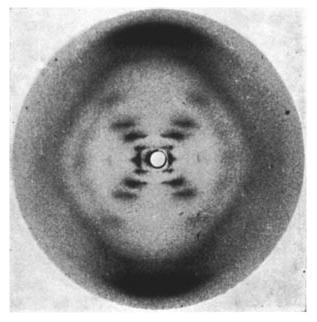It become pretty much a routine, albeit an expensive one, to use transmission electron microscopes for imaging atoms in a crystal. But what has often been missing from those images is a crucial bit of information, the identity of the chemical element that has been looked at. Of course, the grey scales in the contrast of the different atoms do provide some information on the identity of an atom – at least as long as it was already known what kind of crystal is imaged. A more detailed and flexible elemental analysis, however, has been difficult. Writing in Physical Review Letters, Knut Urban from the Forschungszentrum Jülich in Germany and colleagues now report an improved energy-filtering technique that is able to do a full elemental mapping on the atomic scale. […]
Archive | Condensed Matter Physics RSS feed for this archive
X-ray crystallography made easy
April 1, 2013
Sixty years ago this month Nature published the famous paper by Watson and Crick solving the structure of DNA. At the time many researchers pursued this goal, made difficult by the complexity of the DNA itself. A key contribution to the solution of the puzzle was the x-ray diffraction data provided by Rosalind Franklin. Indeed, without x-ray diffraction experiments this discovery would have been almost impossible at the time.

Rosalind Franklin’s x-ray diffraction image of DNA. (c) Nature Magazine. Franklin, R. & Gosling, R. G. Nature 171, 740-741 (1953) – doi:10.1038/171740a0
The way x-ray crystallography works is that a beam of x-rays is directed at a crystal, where the x-rays bounce off the atoms. Because the atoms in a crystal are periodically arranged, the x-rays form complex but regular patterns (such as the one seen for DNA). A detailed analysis of these patterns enables the precise determination of the crystal structure.
To this day such experiments aren’t easy. They require relatively large crystals and typically are done at major facilities such as electron synchrotrons. The synthesis of the crystals for these experiments can often be very difficult.
Yasuhide Inokuma, Makoto Fujita and colleagues from the University of Tokyo in Japan and the University of Jyväskylä in Finland have now developed a clever method that does away with many limitations of x-ray crystallography. Their method works with tiny amounts of material, only about a half to 5 micrograms are enough. This is around a millionth of a gram – truly tiny. The difference between a microgram and a gram is the same as that between a gram and a metric ton. In addition, another major advance of their method is that the target molecules don’t even need to be in a crystalline state. […]
Samarium hexaboride
December 12, 2012
There is a lot of buzz in the physics community about a new topological insulator: samarium hexaboride, SmB6. The reason why any major discovery about topological insulators seems to be big news is that these materials have some unique electrical characteristics that make them not only very interesting from a fundamental point of view but also for electronic applications.
Topological insulators are electrically insulating in their interior, but at the surface they do conduct current. Moreover, the surface currents are topologically protected (hence the name), which means that the electrons that carry those currents don’t veer off the track easily and maintain their properties over long distance. Although a number of topological insulator compounds are known, the problem so far has been that it has been difficult to fabricate these with sufficient purity such that the interior was indeed insulating. This has been a problem, as the electrical current inside the materials just overwhelms the surface properties. […]


June 9, 2013
3 Comments